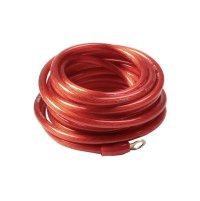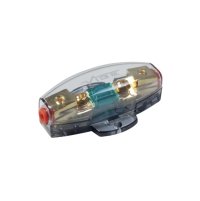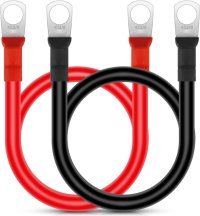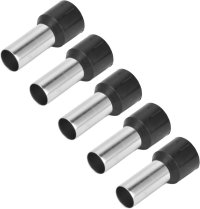You are using an out of date browser. It may not display this or other websites correctly.
You should upgrade or use an alternative browser.
You should upgrade or use an alternative browser.
[Guide] DC-DC Charger (for leisure battery) -- How I Done It --
- Thread starter Dellmassive
- Start date
It is this wire…@t6blo Thinking about this some more.
Do you know the specification of the cable you’ve used? Known manufacturer? Known supplier?
Definitely copper core?
- 4 AWG CCA Power and Earth cable

I have one of these fuses in the engine bay approx 10cm from battery, then some of this wire to under passenger seat, then another one of those fuses, then across with this wire to the alternator input on the Renogy under driver seat.

If this wire is sh1te then I have no issue replacing it - the connections between the Renogy, earth and the Fogstar battery are these but they’re not getting warm.

I’ve dipped the Renogy from 50a to 30a for now
Last edited:
@t6blo
Hmm…. Had a quick look for a proper spec but couldn’t find anything. Vibe says it’s high strand copper with a silicone sheath but nothing on rated current, but at that size and being copper I can’t think of any reason why it wouldn’t be suitable: Silicone actually has a wider temperature range than PVC, so it’s odd that you are losing flexibility, as well as it heating up.
Did you buy from a reputable source? Just to remove the possibility of it being some Chinese (copper coated aluminium) knock off!
How does the cable connect to those fuses? Not familiar with them at all, but it isn’t a screw terminal is it?
If so I reckon that’s the source of your issue.
Hmm…. Had a quick look for a proper spec but couldn’t find anything. Vibe says it’s high strand copper with a silicone sheath but nothing on rated current, but at that size and being copper I can’t think of any reason why it wouldn’t be suitable: Silicone actually has a wider temperature range than PVC, so it’s odd that you are losing flexibility, as well as it heating up.
Did you buy from a reputable source? Just to remove the possibility of it being some Chinese (copper coated aluminium) knock off!
How does the cable connect to those fuses? Not familiar with them at all, but it isn’t a screw terminal is it?
If so I reckon that’s the source of your issue.
@t6bloThanks @EAN
I am using these ferrules and inserting into the fuse holder and clamping down with the supplied gold plated grub screws.
View attachment 223365
The cable was from Amazon UK and came in a Vibe kit blister pack which included some RCAs and speaker cable. It is an 80a ANL fuse.
I expect that the connection between the grub screw and the ferrule is forming a resistance that is, potentially, the cause of your heating issue. Cant guarantee it but cable seems sound so that’s where I would think the problem lies.
i would personally replace them with midi fuse holders that have a decent bolt down connection.
High Power Fuse Holders
Suppliers of high quality electrical parts, components & accessories for campervans, motorhomes, boats & off-grid applications.
www.12voltplanet.co.uk
My only thought here is that Vibe normally supply cables for the audio market rather than power distribution.
While amplifiers can generate huge surge currents the equivalent continuous current can be remarkably low, so the physical cable makeup may be optimised for that. In particular audio type cables tend to have a much higher number of finer cores.
For high current use you really want to use the battery type crimp terminals that need a lot of force - the idea is that the force is sufficient that it melds the soft copper into a single mass so current can easily transfer into all the cores (as well as keep corrosion out)

 www.t6forum.com
www.t6forum.com
While amplifiers can generate huge surge currents the equivalent continuous current can be remarkably low, so the physical cable makeup may be optimised for that. In particular audio type cables tend to have a much higher number of finer cores.
For high current use you really want to use the battery type crimp terminals that need a lot of force - the idea is that the force is sufficient that it melds the soft copper into a single mass so current can easily transfer into all the cores (as well as keep corrosion out)

Battery cable crimping tool recommendation please
next up is this beauty . . . my first port of call and go to large crimper. it will crimp most large lugs and crimps . . . . if it fits on the gap . . . it will crimp it. I've have some tough crimps before . . . and even with 15stone leaning down on it its not broke. its big at 13 inches...
Good/cheap/Aliexpress don’t usually appear in the same sentence. It reminds of the young lad that goes into a second hand car dealership & asks for a fast, reliable, cheap car. The salesman tells him to pick 2 out of 3.….is there something good and cheap on aliexpress..
@t6blo
I expect that the connection between the grub screw and the ferrule is forming a resistance that is, potentially, the cause of your heating issue. Cant guarantee it but cable seems sound so that’s where I would think the problem lies.
i would personally replace them with midi fuse holders that have a decent bolt down connection.
High Power Fuse Holders
Suppliers of high quality electrical parts, components & accessories for campervans, motorhomes, boats & off-grid applications.www.12voltplanet.co.uk
My only thought here is that Vibe normally supply cables for the audio market rather than power distribution.
While amplifiers can generate huge surge currents the equivalent continuous current can be remarkably low, so the physical cable makeup may be optimised for that. In particular audio type cables tend to have a much higher number of finer cores.
For high current use you really want to use the battery type crimp terminals that need a lot of force - the idea is that the force is sufficient that it melds the soft copper into a single mass so current can easily transfer into all the cores (as well as keep corrosion out)

Battery cable crimping tool recommendation please
next up is this beauty . . . my first port of call and go to large crimper. it will crimp most large lugs and crimps . . . . if it fits on the gap . . . it will crimp it. I've have some tough crimps before . . . and even with 15stone leaning down on it its not broke. its big at 13 inches...www.t6forum.com
Thanks both.
I have reduced the Renogy down to 30A for now, but because the battery is now fully charged it is only trickle charging it a few amps and not getting warm at all, so will see what happens when it is discharged and the Renogy runs for a longer period.
Having said that, I am now dubious about it so will likely replace the vibe fuse in the engine bay, remove the vibe fuse holder under the passenger seat and replace the two runs of vibe cable (engine bay to passenger seat and passenger seat to drivers seat) to replace it with a single run of 3m proper split charge 4AWG cable.
Can I get a piece 3m long with pre-crimped ring terminals on?
Not confident with a crimping tool.
I know 12v Planet do premade leads in "bank" and "charger" lengths but I think the longest advertised one in the shop is about a meter, might be worth dropping them a line to see if they'd do a custom length. If nothing else the run you put in would be an accurate measure?
Might also be worth a post on the the crimping thread I linked to to see if there is anyone local who might help or lend you a crimper, there were a few folks volunteering.
Only place I found online when I was looking was this, though I have no experience of them nor have I heard of them around the forum that I recall, currently the second battery project is shelved
 www.electricalcarservices.com
www.electricalcarservices.com
Might also be worth a post on the the crimping thread I linked to to see if there is anyone local who might help or lend you a crimper, there were a few folks volunteering.
Only place I found online when I was looking was this, though I have no experience of them nor have I heard of them around the forum that I recall, currently the second battery project is shelved
25mm² Lead up to 4mtrs long with 1 or 2 Ring terminals | Electrical Car Services
Buy 25mm² Lead up to 4mtrs long with 1 or 2 Ring terminals - BLRT25/4The Tech Spec: Battery Lead Amperage: 170 amps Cable Cross Section: 25.0 mm² AWG number: 3 Conductor Construction: 322/0.30 Ømm Resistance per metre at 20°c: 0.00077 Ω/km Diameter including insulation: 10.1 Ømm Ring terminals...
In the past I’ve gone to a local motorfactors with measurements and they’ve made me cables up quite cheaply.
John.
John.
Last edited:
Yup, any local auto electrician will make the cables up for youIn the past I’ve gone to a local motorfactors with measurements and they’ve made me cables up quite cheaply.
John.l
@t6blo If you were local to me I’d certainly help you out, but you are about a 6.5hr round trip from me.
Hopefully someone nearer to you on the forum will assist.
Appreciated

In the past I’ve gone to a local motorfactors with measurements and they’ve made me cables up quite cheaply.
John.
Thanks for the tip - don’t recall seeing one round here anymore
Yup, any local auto electrician will make the cables up for you
Good shout - thanks.
I found these on fleabay….
Just to add to this they now do a BB1210, which is a software downrated version of the BB1225.I only need it to run the fridge on days out and lights for a few hours - we're a day trip van not a camper.
50ah should give us broadly the capacity of a regular AGM but be a lot easier to tuck under the seat bases.
I actually want to try and downrate the charger (which you can with the remote) as I want to repurpose the existing 30amp towbar feed to avoid disturbing much while I'm still in factory warranty.
It seems other folks have use cases for a lower current DC-DC solution, and Sterling are fairly explicit in the video summary that they expect it to be used to help charge power packs or similar systems where existing wiring can be refused.
Quite tempted, just need to properly plan what is where in my existing wiring as adding a second battery only really makes sense in our use of the van if I can move the 12v sockets to it easily and ideally the interior lights in the back.
Hi, there is also a new interesting DC-DC charger Orion XS from Victron with programable curent up to 50A. Its smaller than the older Orion-TR chargers and Victron says that it works with better efficiency than older units. I am now in the decision if to wait for a new version of Renogy 50A charger with its rised 50V solar input once its available in EU or to get this new Victron XS with separate MPPT Victron charger as I bought a T6 where previous owner instaled wrongly Cyrix relay to charge a second battery...
Orion XS 12/12-50A DC-DC Battery Charger - Victron Energy
Orion XS 12/12-50A DC-DC Battery Charger - Victron Energy
Last edited:
stoic
Member
what's with the 3rd one?Good/cheap/Aliexpress don’t usually appear in the same sentence. It reminds of the young lad that goes into a second hand car dealership & asks for a fast, reliable, cheap car. The salesman tells him to pick 2 out of 3.
Speaking about DC to DC charger, isn't the current factory setup, basically just a relay activated by the engine run, enabling moving current both ways? Doesn't that mean the start-stop engine function will be more active, since, after first engine start and discharging, the leisure battery would actually top up faster than the EURO 6 alternator?
I walked through the downsides of basic split charge relay and why DC-DC is better here:

 www.t6forum.com
www.t6forum.com

Lithium LifePo4 12v Batteries - Time For An Upgrade?
Hi, One question. Actually I have the default battery coming with the van: AGM battery of 100ah (the battery is only 1 year old). I have been looking for information, but it is not very clear: some places says if you want an extra battery, you need to discard your current battery. That you...
stoic
Member
How do I wire it up so the factory webasto takes its electricity from the 2nd battery? If I take out the relay and put +12v "engine on" to DC DC charger, and connect the thick wires through the DC to DC charger then to battery, where/how is the current flowing into factory webasto? I'm not sure, but I think I hear the relay clicking when webasto is started, with engine off. That would mean, the 2 batteries are connected in parralel and in fact power is drawn from both (by the webasto, in parked mode)?
I fitted the victron dc to dc charger (30amp) 18 months ago in the space infront of the vehical battery and drilled some holes in the plastic casing for air flow. Used good quality cables back to battery (Lithium LifePo4 180amp)
When we move on to next place within 90 seconds of starting camper the charger kicks in giving me around 28/30amps as well as the solar giving me (this time of year around 7amps (200 watt panel) total of 37amps ish. If the battery is sitting around 90/125amp left mark, I can charge it to full in a 2/3 hour drive. The dc to dc charger does get hot, but the air flow around it helps. I remove the basic split charge relay as it was not doing the job at all.
Would love the new one from victron, but until current one fails it can wait. Great bit of kit.
When we move on to next place within 90 seconds of starting camper the charger kicks in giving me around 28/30amps as well as the solar giving me (this time of year around 7amps (200 watt panel) total of 37amps ish. If the battery is sitting around 90/125amp left mark, I can charge it to full in a 2/3 hour drive. The dc to dc charger does get hot, but the air flow around it helps. I remove the basic split charge relay as it was not doing the job at all.
Would love the new one from victron, but until current one fails it can wait. Great bit of kit.
Last edited:
I'm not sure I understand what you are doing here but to run equipment off the second battery you will need to move it's supply to the second battery.How do I wire it up so the factory webasto takes its electricity from the 2nd battery? If I take out the relay and put +12v "engine on" to DC DC charger, and connect the thick wires through the DC to DC charger then to battery, where/how is the current flowing into factory webasto? I'm not sure, but I think I hear the relay clicking when webasto is started, with engine off. That would mean, the 2 batteries are connected in parralel and in fact power is drawn from both (by the webasto, in parked mode)?
That does not need anything doing to the the charge system, engaging the charging system (of any kind) while parked is exactly what you don't want as it will drain both batteries leaving you with no options to start the vehicle.
There are other relays than the charger one so just hearing a click isn't enough to go on. If you take up VIP Membership then wiring diagrams are available.
Similar threads
- Replies
- 16
- Views
- 958
- Replies
- 4
- Views
- 968
- Replies
- 47
- Views
- 1K
- Replies
- 39
- Views
- 2K

